Objective 1. Start Excel and Navigate a Workbook
When you start the Excel program, a new blank workbook displays. A workbook contains one or more pages called worksheets. A worksheet is formatted as a pattern of uniformly spaced horizontal and vertical lines. This grid pattern of the worksheet forms vertical columns and horizontal rows. The intersection of a column and a row forms a small rectangular box referred to as a cell.
Activity 1.1. Starting Excel and Saving a Workbook
In this activity, you will start Excel and use the first worksheet in the workbook to prepare a report of expenses for the Dallas restaurant. Start Excel in the same manner as you start other Microsoft Office 2003 programs.
|
1. |
On the Windows taskbar, click the Start button Figure 1.2. 
|
||||||||||||||||||||||||||||
|
|
|||||||||||||||||||||||||||||
|
2. |
Point to All Programs, determine where the Excel program is located, point to Microsoft Office Excel 2003, and then click once to start the program. Compare your screen with Figure 1.3. Figure 1.3. 
Excel opens, and a blank workbook displays. The default Excel working environment consists of a menu bar, toolbars across the top of the window, and a main window divided into two sectionsthe task pane on the right and the worksheet grid on the left. A task pane is an area within a Microsoft Office application that displays commands related to the current task. Its location and small size give you easy access to these commands while still working on your workbook. |
||||||||||||||||||||||||||||
|
3. |
In the upper right corner of the Getting Started task pane, click the Close button |
||||||||||||||||||||||||||||
|
|
|||||||||||||||||||||||||||||
|
4. |
Take a moment to study Figures 1.4 and 1.5 and the table in Figure 1.6 to become familiar with the parts of the Excel window. Figure 1.4. 
Figure 1.5. 
|
||||||||||||||||||||||||||||
|
5. |
On the menu bar, click File to display the File menu, click Save As, and then compare your screen with Figure 1.7. Figure 1.7. 
|
||||||||||||||||||||||||||||
|
6. |
In the displayed Save As dialog box, click the Save in arrow to view a list of the drives available to you, and then navigate to the drive on which you will be storing your projects for this chapterfor example, a USB flash drive such as the one shown in Figure 1.8. Figure 1.8. 
|
||||||||||||||||||||||||||||
|
|
|||||||||||||||||||||||||||||
|
7. |
In the upper right corner of the Save As dialog box, click the Create New Folder button Figure 1.9. 
|
||||||||||||||||||||||||||||
|
8. |
In the New Folder dialog box, click OK. |
||||||||||||||||||||||||||||
|
9. |
In the File name box, using your own first and last name, replace Book1, which is highlighted in blue, by typing 1A_Tableware_Firstname_Lastname being sure to include the underscore ( Figure 1.10. (This item is displayed on page 594 in the print version) 
Windows recognizes file names that use spaces between words. However, some electronic file transfer programs do not. In this text, you will use underscores instead of spaces between words for your file names. Text highlighted in blue in a Windows dialog box will be replaced by your new typing. Alternatively, use the  key to delete text in a box, and then type. key to delete text in a box, and then type. |
||||||||||||||||||||||||||||
|
|
|||||||||||||||||||||||||||||
|
10. |
In the lower right corner of the Save As dialog box, click Save. |
Activity 1.2. Navigating the Excel Menu Bar, ScreenTips, and the Toolbar
In this activity, you will verify that your system is set so that you can use Excel easily, and you will also review several Windows features to see how they function within the Excel program.
|
1. |
On the menu bar, click File. Figure 1.11. (This item is displayed on page 595 in the print version) 
Figure 1.12. (This item is displayed on page 595 in the print version) 
The File menu, when displayed in full, lists the last four to nine workbooks used on your computer. Whether your full menu displays immediately or is delayed by a few seconds depends on the options that are set for this software. Likewise, the number of previous workbook names displayed depends on how the software was set up. These default settings can be changed in the Options dialog boxdisplayed from the Tools menuon systems where it is permissible to do so. NoteDisplaying Full Menus Many Excel users prefer the automatic full menu display. To set a system to always display full menus, display the Tools menu, click Customize, and then click the Options tab. Under Personalized Menus and Toolbars, select the Always show full menus check box. Click the Reset menu and toolbar usage data button, click Yes, and then click Close. |
||||||||||||||||||
|
|
|||||||||||||||||||
|
2. |
If the full menu is not displayed, pause your mouse pointer over the Expand arrow to expand the File menu. Compare your screen with Figure 1.13. Figure 1.13. 
On the left side of some command names is an image of the button that represents this command on a toolbar. This is a reminder that you can use the toolbar button to start the command with only one click. Likewise, to the right of some commands is a reminder that you can use a keyboard shortcutholding down a combination of keys to start the command. |
||||||||||||||||||
|
3. |
Look at the full File menu on your screen.
|
||||||||||||||||||
|
|
|||||||||||||||||||
|
4. |
On the menu bar, click File again to close the menu. |
||||||||||||||||||
|
5. |
On the menu bar, click View, and then point to Toolbars. |
||||||||||||||||||
|
6. |
On the displayed list of toolbars, be sure that Standard and Formatting are both checked. Clear any other checked toolbar on the list by clicking its check mark to clear it, and then, if the list is still displayed, click outside the menu to close it. |
||||||||||||||||||
|
7. |
Below the menu bar, be sure two rows of toolbars display, as shown in Figure 1.15. If, instead, your toolbars are sharing one row, as shown in Figure 1.16, at the end of the toolbar click the Toolbar Options button Figure 1.15. 
Figure 1.16. (This item is displayed on page 598 in the print version) 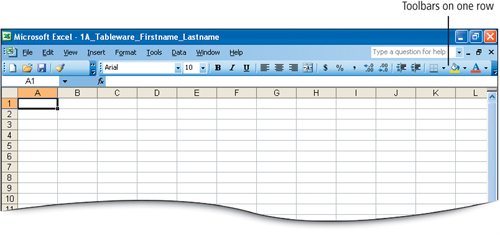
The toolbars will display on two rows, as shown in Figure 1.15. Alternatively, from the Tools menu, click Customize, click the Options tab, and then select the Show Standard and Formatting toolbars on two rows check box. |
||||||||||||||||||
|
|
|||||||||||||||||||
|
8. |
On the Standard toolbar, locate and pause your mouse pointer over the New button Figure 1.17. 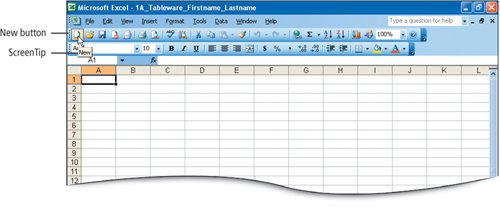
When you position the mouse pointer over a button, Excel displays the button's name in a ScreenTip. The ScreenTip New displays, indicating that clicking this button will activate the command to create a new workbook. |
||||||||||||||||||
|
9. |
Pause your pointer over several buttons on both the Standard and Formatting toolbars to become familiar with the commands available to you. Recall that a toolbar button is a one-click method to activate frequently used commands that are also available from the menus. The ScreenTip describes the command that will be activated when you click the toolbar button. |
Activity 1.3. Navigating a Worksheet
In this activity, you will navigate the Excel workbook window.
|
1. |
Take a moment to study Figures 1.18 and 1.19 and the table in Figure 1.20 to become familiar with the Excel workbook window. Figure 1.18. 
Figure 1.19. (This item is displayed on page 600 in the print version) 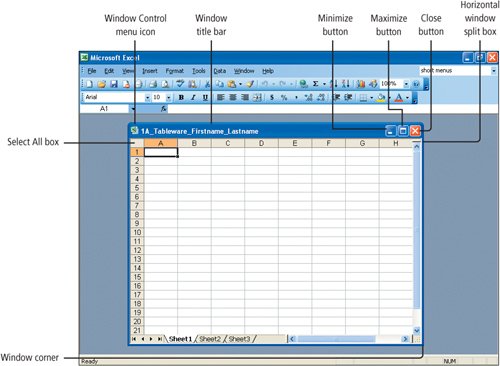
A workbook displays as a window within the Excel window with its own sizing buttons. Figure 1.18 shows the workbook maximized, and Figure 1.19 shows the workbook at an intermediate size. |
||||||||||||||||||||||||||||||||||||
|
|
|||||||||||||||||||||||||||||||||||||
|
2. |
In the horizontal scroll bar, point to and then click the right scroll arrow. Compare your screen with Figure 1.21. Figure 1.21. (This item is displayed on page 602 in the print version) 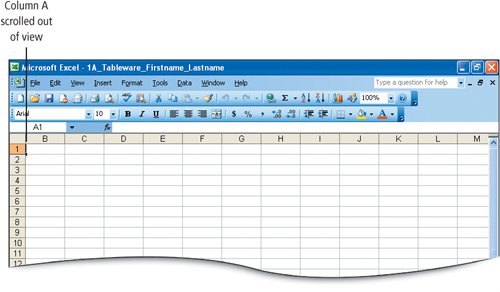
The workbook window shifts so that column A moves out of view. The number of times you click the arrows on the horizontal scroll bar determines the number of columns by which the window shiftseither to the left or to the right. The number of columns that display on your screen may be different depending on the screen resolution that is set for your monitor. |
||||||||||||||||||||||||||||||||||||
|
|
|||||||||||||||||||||||||||||||||||||
|
3. |
In the horizontal scroll bar, click the right scroll arrow and hold the mouse button down until the columns begin to scroll rapidly to the right; release when you begin to see pairs of letters as the column headings. |
||||||||||||||||||||||||||||||||||||
|
4. |
In the horizontal scroll bar, click the left scroll arrow to shift one column. |
||||||||||||||||||||||||||||||||||||
|
5. |
In the horizontal scroll bar, point to the horizontal scroll box, hold down the left mouse button, drag the box to the left to display column A, and then release the mouse button. |
||||||||||||||||||||||||||||||||||||
|
6. |
Use the techniques you just practiced to scroll the worksheet to position column Z near the center of your screen, and then compare your screen with Figure 1.22. Figure 1.22. (This item is displayed on page 603 in the print version) 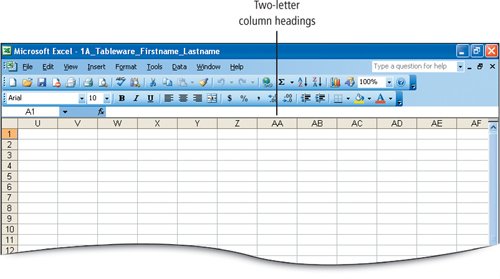
Column headings to the right of column Z use two letters starting with AA. After using the entire alphabet from A to Z, Excel begins naming the columns AA, AB, AC, and then starts over again with BA, BB, BC, and so on. This pattern is used to name up to 256 columns. The last column available is column IV. The number of columns that display on your screen may be different depending on the screen resolution that is set for your monitor. |
||||||||||||||||||||||||||||||||||||
|
|
|||||||||||||||||||||||||||||||||||||
|
7. |
Near the bottom left of the screen, point to and then click the Sheet2 tab. |
||||||||||||||||||||||||||||||||||||
|
8. |
Click the Sheet1 tab. |
||||||||||||||||||||||||||||||||||||
|
9. |
In the vertical scroll bar, point to and then click the down scroll arrow one time. |
||||||||||||||||||||||||||||||||||||
|
10. |
In the vertical scroll bar, point to and then click the up scroll arrow. |
||||||||||||||||||||||||||||||||||||
|
11. |
Use the skills you just practiced to scroll horizontally to display column A. |
Objective 2 Select Parts of a Worksheet |
Windows XP
- Chapter One. Getting Started with Windows XP
- Project 1A. Windows XP
- Objective 1. Get Started with Windows XP
- Objective 2. Resize, Move, and Scroll Windows
- Objective 3. Maximize, Restore, Minimize, and Close a Window
- Objective 4. Create a New Folder
- Objective 5. Copy, Move, Rename, and Delete Files
- Objective 6. Find Files and Folders
- Objective 7. Compress Files
- Summary
- Key Terms
- Concepts Assessments
Outlook 2003
- Chapter One. Getting Started with Outlook 2003
- Getting Started with Microsoft Office Outlook 2003
- Project 1A. Exploring Outlook 2003
- Objective 1. Start and Navigate Outlook
- Objective 2. Read and Respond to E-mail
- Objective 3. Store Contact and Task Information
- Objective 4. Work with the Calendar
- Objective 5. Delete Outlook Information and Close Outlook
- Summary
- Key Terms
- Concepts Assessments
- Skill Assessments
- Performance Assessments
- Mastery Assessments
- Problem Solving
- GO! with Help
Internet Explorer
- Chapter One. Getting Started with Internet Explorer
- Getting Started with Internet Explorer 6.0
- Project 1A. College and Career Information
- Objective 1. Start Internet Explorer and Identify Screen Elements
- Objective 2. Navigate the Internet
- Objective 3. Create and Manage Favorites
- Objective 4. Search the Internet
- Objective 5. Save and Print Web Pages
- Summary
- Key Terms
- Concepts Assessments
- Skill Assessments
- Performance Assessments
- Mastery Assessments
- Problem Solving
Computer Concepts
- Chapter One. Basic Computer Concepts
- Objective 1. Define Computer and Identify the Four Basic Computing Functions
- Objective 2. Identify the Different Types of Computers
- Objective 3. Describe Hardware Devices and Their Uses
- Objective 4. Identify Types of Software and Their Uses
- Objective 5. Describe Networks and Define Network Terms
- Objective 6. Identify Safe Computing Practices
- Summary
- In this Chapter You Learned How to
- Key Terms
- Concepts Assessments
Word 2003
Chapter One. Creating Documents with Microsoft Word 2003
- Chapter One. Creating Documents with Microsoft Word 2003
- Getting Started with Microsoft Office Word 2003
- Project 1A. Thank You Letter
- Objective 1. Create and Save a New Document
- Objective 2. Edit Text
- Objective 3. Select, Delete, and Format Text
- Objective 4. Create Footers and Print Documents
- Project 1B. Party Themes
- Objective 5. Navigate the Word Window
- Objective 6. Add a Graphic to a Document
- Objective 7. Use the Spelling and Grammar Checker
- Objective 8. Preview and Print Documents, Close a Document, and Close Word
- Objective 9. Use the Microsoft Help System
- Summary
- Key Terms
- Concepts Assessments
- Skill Assessments
- Performance Assessments
- Mastery Assessments
- Problem Solving
- You and GO!
- Business Running Case
- GO! with Help
Chapter Two. Formatting and Organizing Text
- Formatting and Organizing Text
- Project 2A. Alaska Trip
- Objective 1. Change Document and Paragraph Layout
- Objective 2. Change and Reorganize Text
- Objective 3. Create and Modify Lists
- Project 2B. Research Paper
- Objective 4. Insert and Format Headers and Footers
- Objective 5. Insert Frequently Used Text
- Objective 6. Insert and Format References
- Summary
- Key Terms
- Concepts Assessments
- Skill Assessments
- Performance Assessments
- Mastery Assessments
- Problem Solving
- You and GO!
- Business Running Case
- GO! with Help
Chapter Three. Using Graphics and Tables
- Using Graphics and Tables
- Project 3A. Job Opportunities
- Objective 1. Insert and Modify Clip Art and Pictures
- Objective 2. Use the Drawing Toolbar
- Project 3B. Park Changes
- Objective 3. Set Tab Stops
- Objective 4. Create a Table
- Objective 5. Format a Table
- Objective 6. Create a Table from Existing Text
- Summary
- Key Terms
- Concepts Assessments
- Skill Assessments
- Performance Assessments
- Mastery Assessments
- Problem Solving
- You and GO!
- Business Running Case
- GO! with Help
Chapter Four. Using Special Document Formats, Columns, and Mail Merge
- Using Special Document Formats, Columns, and Mail Merge
- Project 4A. Garden Newsletter
- Objective 1. Create a Decorative Title
- Objective 2. Create Multicolumn Documents
- Objective 3. Add Special Paragraph Formatting
- Objective 4. Use Special Character Formats
- Project 4B. Water Matters
- Objective 5. Insert Hyperlinks
- Objective 6. Preview and Save a Document as a Web Page
- Project 4C. Recreation Ideas
- Objective 7. Locate Supporting Information
- Objective 8. Find Objects with the Select Browse Object Button
- Project 4D. Mailing Labels
- Objective 9. Create Labels Using the Mail Merge Wizard
- Summary
- Key Terms
- Concepts Assessments
- Skill Assessments
- Performance Assessments
- Mastery Assessments
- Problem Solving
- You and GO!
- Business Running Case
- GO! with Help
Excel 2003
Chapter One. Creating a Worksheet and Charting Data
- Creating a Worksheet and Charting Data
- Project 1A. Tableware
- Objective 1. Start Excel and Navigate a Workbook
- Objective 2. Select Parts of a Worksheet
- Objective 3. Enter and Edit Data in a Worksheet
- Objective 4. Construct a Formula and Use the Sum Function
- Objective 5. Format Data and Cells
- Objective 6. Chart Data
- Objective 7. Annotate a Chart
- Objective 8. Prepare a Worksheet for Printing
- Objective 9. Use the Excel Help System
- Project 1B. Gas Usage
- Objective 10. Open and Save an Existing Workbook
- Objective 11. Navigate and Rename Worksheets
- Objective 12. Enter Dates and Clear Formats
- Objective 13. Use a Summary Sheet
- Objective 14. Format Worksheets in a Workbook
- Summary
- Key Terms
- Concepts Assessments
- Skill Assessments
- Performance Assessments
- Mastery Assessments
- Problem Solving
- You and GO!
- Business Running Case
- GO! with Help
Chapter Two. Designing Effective Worksheets
- Designing Effective Worksheets
- Project 2A. Staff Schedule
- Objective 1. Use AutoFill to Fill a Pattern of Column and Row Titles
- Objective 2. Copy Text Using the Fill Handle
- Objective 3. Use AutoFormat
- Objective 4. View, Scroll, and Print Large Worksheets
- Project 2B. Inventory Value
- Objective 5. Design a Worksheet
- Objective 6. Copy Formulas
- Objective 7. Format Percents, Move Formulas, and Wrap Text
- Objective 8. Make Comparisons Using a Pie Chart
- Objective 9. Print a Chart on a Separate Worksheet
- Project 2C. Population Growth
- Objective 10. Design a Worksheet for What-If Analysis
- Objective 11. Perform What-If Analysis
- Objective 12. Compare Data with a Line Chart
- Summary
- Key Terms
- Concepts Assessments
- Skill Assessments
- Performance Assessments
- Mastery Assessments
- Problem Solving
- You and GO!
- Business Running Case
- GO! with Help
Chapter Three. Using Functions and Data Tables
- Using Functions and Data Tables
- Project 3A. Geography Lecture
- Objective 1. Use SUM, AVERAGE, MIN, and MAX Functions
- Objective 2. Use a Chart to Make Comparisons
- Project 3B. Lab Supervisors
- Objective 3. Use COUNTIF and IF Functions, and Apply Conditional Formatting
- Objective 4. Use a Date Function
- Project 3C. Loan Payment
- Objective 5. Use Financial Functions
- Objective 6. Use Goal Seek
- Objective 7. Create a Data Table
- Summary
- Key Terms
- Concepts Assessments
- Skill Assessments
- Performance Assessments
- Mastery Assessments
- Problem Solving
- You and GO!
- Business Running Case
- GO! with Help
Access 2003
Chapter One. Getting Started with Access Databases and Tables
- Getting Started with Access Databases and Tables
- Project 1A. Academic Departments
- Objective 1. Rename a Database
- Objective 2. Start Access, Open an Existing Database, and View Database Objects
- Project 1B. Fundraising
- Objective 3. Create a New Database
- Objective 4. Create a New Table
- Objective 5. Add Records to a Table
- Objective 6. Modify the Table Design
- Objective 7. Create Table Relationships
- Objective 8. Find and Edit Records in a Table
- Objective 9. Print a Table
- Objective 10. Close and Save a Database
- Objective 11. Use the Access Help System
- Summary
- Key Terms
- Concepts Assessments
- Skill Assessments
- Performance Assessments
- Mastery Assessments
- Problem Solving Assessments
- Problem Solving
- You and GO!
- Business Running Case
- GO! with Help
Chapter Two. Sort, Filter, and Query a Database
- Sort, Filter, and Query a Database
- Project 2A. Club Fundraiser
- Objective 1. Sort Records
- Objective 2. Filter Records
- Objective 3. Create a Select Query
- Objective 4. Open and Edit an Existing Query
- Objective 5. Sort Data in a Query
- Objective 6. Specify Text Criteria in a Query
- Objective 7. Print a Query
- Objective 8. Specify Numeric Criteria in a Query
- Objective 9. Use Compound Criteria
- Objective 10. Create a Query Based on More Than One Table
- Objective 11. Use Wildcards in a Query
- Objective 12. Use Calculated Fields in a Query
- Objective 13. Group Data and Calculate Statistics in a Query
- Summary
- Key Terms
- Concepts Assessments
- Skill Assessments
- Performance Assessments
- Mastery Assessments
- Problem Solving
- You and GO!
- Business Running Case
- GO! with Access Help
Chapter Three. Forms and Reports
- Forms and Reports
- Project 3A. Fundraiser
- Objective 1. Create an AutoForm
- Objective 2. Use a Form to Add and Delete Records
- Objective 3. Create a Form Using the Form Wizard
- Objective 4. Modify a Form
- Objective 5. Create an AutoReport
- Objective 6. Create a Report Using the Report Wizard
- Objective 7. Modify the Design of a Report
- Objective 8. Print a Report and Keep Data Together
- Summary
- Key Terms
- Concepts Assessments
- Skill Assessments
- Performance Assessments
- Mastery Assessments
- Problem Solving
- You and GO!
- Business Running Case
- GO! with Help
Powerpoint 2003
Chapter One. Getting Started with PowerPoint 2003
- Getting Started with PowerPoint 2003
- Project 1A. Expansion
- Objective 1. Start and Exit PowerPoint
- Objective 2. Edit a Presentation Using the Outline/Slides Pane
- Objective 3. Format and Edit a Presentation Using the Slide Pane
- Objective 4. View and Edit a Presentation in Slide Sorter View
- Objective 5. View a Slide Show
- Objective 6. Create Headers and Footers
- Objective 7. Print a Presentation
- Objective 8. Use PowerPoint Help
- Summary
- Key Terms
- Concepts Assessments
- Skill Assessments
- Performance Assessments
- Mastery Assessments
- Problem Solving
- You and GO!
- Business Running Case
- GO! with Help
Chapter Two. Creating a Presentation
- Creating a Presentation
- Project 2A. Teenagers
- Objective 1. Create a Presentation
- Objective 2. Modify Slides
- Project 2B. History
- Objective 3. Create a Presentation Using a Design Template
- Objective 4. Import Text from Word
- Objective 5. Move and Copy Text
- Summary
- Key Terms
- Concepts Assessments
- Skill Assessments
- Performance Assessments
- Mastery Assessments
- Problem Solving
- You and GO!
- Business Running Case
- GO! with Help
Chapter Three. Formatting a Presentation
- Project 3A. Emergency
- Objective 1. Format Slide Text
- Objective 2. Modify Placeholders
- Objective 3. Modify Slide Master Elements
- Objective 4. Insert Clip Art
- Project 3B. Volunteers
- Objective 5. Apply Bullets and Numbering
- Objective 6. Customize a Color Scheme
- Objective 7. Modify the Slide Background
- Objective 8. Apply an Animation Scheme
- Summary
- Key Terms
- Concepts Assessments
- Skill Assessments
- Performance Assessments
- Mastery Assessments
- Problem Solving
- You and GO!
- Business Running Case
- GO! with Help
Integrated Projects
Chapter One. Using Access Data with Other Office Applications
- Chapter One. Using Access Data with Other Office Applications
- Introduction
- Project 1A. Meeting Slides
- Objective 1. Export Access Data to Excel
- Objective 2. Create a Formula in Excel
- Objective 3. Create a Chart in Excel
- Objective 4. Copy Access Data into a Word Document
- Objective 5. Copy Excel Data into a Word Document
- Objective 6. Insert an Excel Chart into a PowerPoint Presentation
Chapter Two. Using Tables in Word and Excel
- Chapter Two. Using Tables in Word and Excel
- Introduction
- Project 2A. Meeting Notes
- Objective 1. Plan a Table in Word
- Objective 2. Enter Data and Format a Table in Word
- Objective 3. Create a Table in Word from Excel Data
- Objective 4. Create Excel Worksheet Data from a Word Table
Chapter Three. Using Excel as a Data Source in a Mail Merge
- Chapter Three. Using Excel as a Data Source in a Mail Merge
- Introduction
- Project 3A. Mailing Labels
- Objective 1. Prepare a Mail Merge Document as Mailing Labels
- Objective 2. Choose an Excel Worksheet as a Data Source
- Objective 3. Produce and Save Merged Mailing Labels
- Objective 4. Open a Saved Main Document for Mail Merge
Chapter Four. Linking Data in Office Documents
- Chapter Four. Linking Data in Office Documents
- Introduction
- Project 4A. Weekly Sales
- Objective 1. Insert and Link in Word an Excel Object
- Objective 2. Format an Object in Word
- Objective 3. Open a Word Document That Includes a Linked Object, and Update Links
Chapter Five. Creating Presentation Content from Office Documents
EAN: 2147483647
Pages: 448
 .
. to close the task pane.
to close the task pane. and pressing the underlined letter in the menu name.
and pressing the underlined letter in the menu name. .
. . In the displayed New Folder dialog box, in the Name box, type Excel Chapter 1 and then compare your screen with Figure 1.9.
. In the displayed New Folder dialog box, in the Name box, type Excel Chapter 1 and then compare your screen with Figure 1.9. ) instead of spaces between words. Compare your screen with Figure 1.10.
) instead of spaces between words. Compare your screen with Figure 1.10. (triangle)
(triangle) (check mark)
(check mark) .
. , and then click Show Buttons on Two Rows.
, and then click Show Buttons on Two Rows. . Compare your screen with Figure 1.17.
. Compare your screen with Figure 1.17.